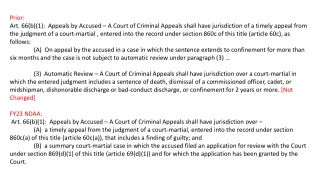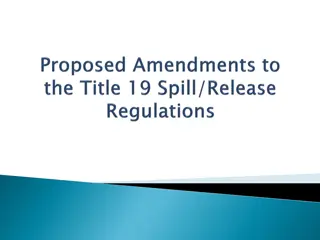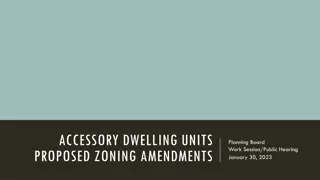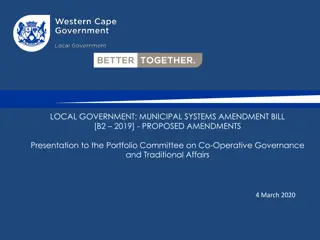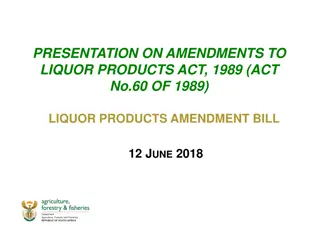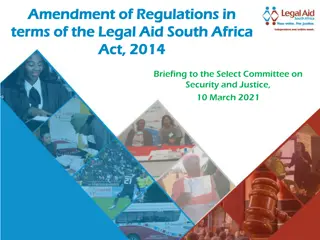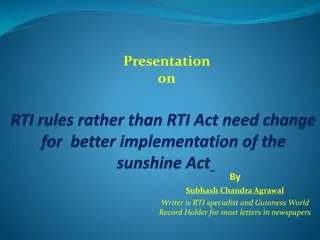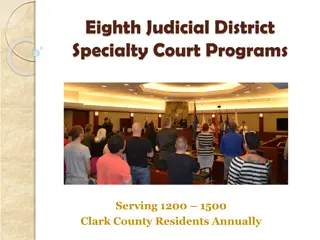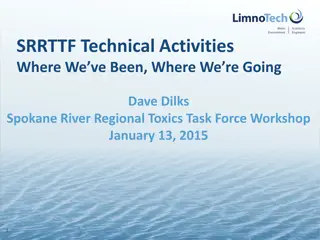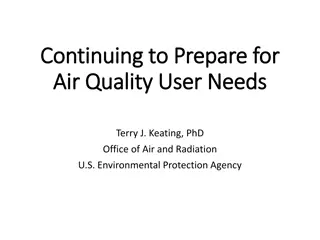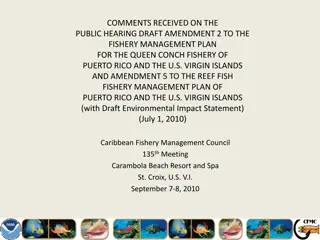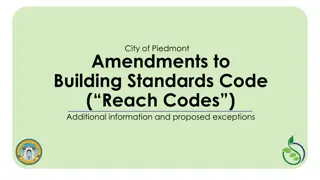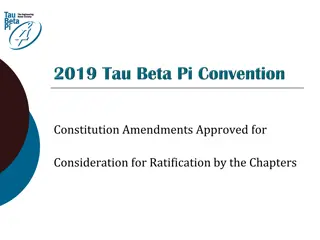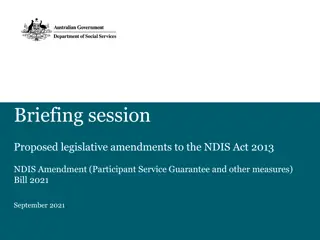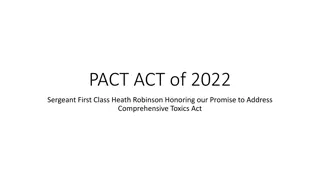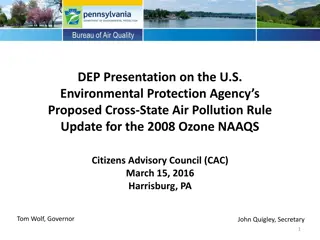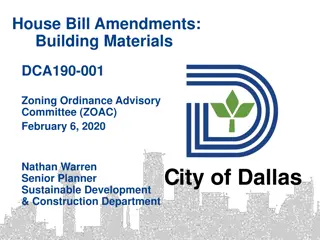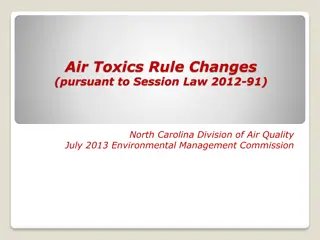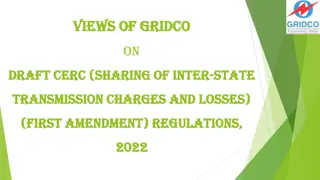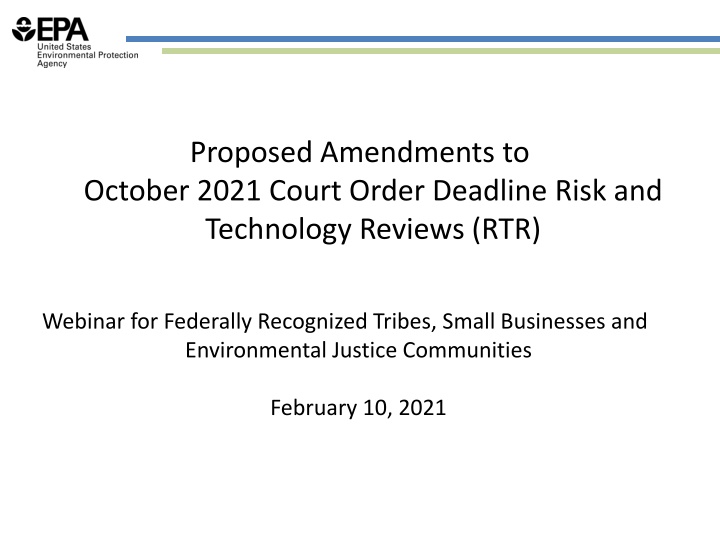
Proposed Amendments to October 2021 Court Order - Air Toxics Program Overview
This content provides insights into the Clean Air Act Amendments of 1990, source regulations, and the two-stage regulatory process for addressing air toxics. Learn about the Risk and Technology Reviews (RTR) related to air quality regulations.
Download Presentation

Please find below an Image/Link to download the presentation.
The content on the website is provided AS IS for your information and personal use only. It may not be sold, licensed, or shared on other websites without obtaining consent from the author. If you encounter any issues during the download, it is possible that the publisher has removed the file from their server.
You are allowed to download the files provided on this website for personal or commercial use, subject to the condition that they are used lawfully. All files are the property of their respective owners.
The content on the website is provided AS IS for your information and personal use only. It may not be sold, licensed, or shared on other websites without obtaining consent from the author.
E N D
Presentation Transcript
Proposed Amendments to October 2021 Court Order Deadline Risk and Technology Reviews (RTR) Webinar for Federally Recognized Tribes, Small Businesses and Environmental Justice Communities February 10, 2021
Overview Air Toxics Program Clean Air Act 1990 Amendments Source Regulations Required Reviews and What is Considered Rulemaking Process 2021 Proposed Rules At a Glance How to Comment Carbon Black Production Cyanide Chemicals Manufacturing Flexible Poly Foam Fabrication Operations Primary Magnesium Refining 2
Air Toxics Program What are air toxics? Also known as Hazardous Air Pollutants (HAPs) 187 substances specified by Congress (1990 Clean Air Act) May cause cancer and other serious health effects (asthma, etc...)
Clean Air Act: Source Regulations Law and Regulation Requires EPA to establish "rules" for source categories of both major and area sources of air toxics Two types of rules which are called National Emission Standards for Hazardous Air Pollutants (NESHAP) Maximum Achievable Control Technology (MACT) standards - major sources Major sources: Facilities that emit or have the capacity to emit 10 tons per year or more of a single air toxin or 25 tons per year or more of total air toxics Generally Available Control Technology (GACT) Standards - area sources Area sources: Facilities that are not major sources; may be subject to GACT rather than MACT
Clean Air Act Amendments 1990 Clean Air Act (CAA) amendments changed the way we regulate air toxics Required EPA to regulate air toxics emissionsfrom source categories based on existing technology (i.e., control devices or work practices) Source categories generally consist of industrial facilities with the same or similar types of processes, products, and equipment
Clean Air Act Required Reviews and Considerations Two-stage regulatory process NESHAP: Establish technology-based standards (e.g., MACT) Residual Risk Review: Evaluate standards that are based on MACT to determine whether additional standards are needed to address any remaining risk associated with HAP emissions Technology Review: Review standards; under section 112 requires EPA to review When the Residual Risk and Technology Reviews are combined into a single rulemaking commonly referred to as the Risk and Technology Review or RTR Residual Risk Review Technology Review Ensure risks are acceptable and standards provide an ample margin of safety Revise standards, if needed, to protect human health or environment Occurs within 8 years of initial rule Focus on new developments in practices, processes and control technologies Changes in cost, availability, or other factors Occurs every 8 years 6
Clean Air Act: Rulemaking Process MACT Standards- Required Review 10 Years (Staggered Schedule) 12 Months EPA published a list of source categories that emit these air toxics Congress identified a list of air toxics (or HAP) to regulate Promulgate NESHAPs 8 Years Every 8 Years Residual Risk and Technology Review Technology Review 7
2021 Proposed Rules At a Glance Rule Original NESHAP Notice Signature (2021) Docket Number Comment Period Carbon Black Production Major source: July 12, 2002 January 5 EPA-HQ- OAR-2020-0505 March 1, 2021 Area source: July 16, 2007 Cyanide Chemicals Manufacturing Major source: July 12, 2002 January 6 EPA-HQ-OAR-2020-0532 March 1, 2021 Flexible Polyurethane Foam Fabrication Operations Major source: April 14, 2003 Area source: July 16, 2007 January 5 EPA-HQ-OAR-2020-0572 February 25, 2021 Primary Magnesium Refining October 10, 2003 January 4 EPA-HQ-OAR-2020-0535 February 22, 2021 8
Carbon Black Production Summary Source Category Any facility that produces carbon black by the furnace black process, thermal black process, or the acetylene decomposition process; primarily used as a reinforcing agent for rubber, largely utilized in the manufacturing of automotive tires Carbon black manufacturing process unit is assembled and connected by hard-piping or duct work that processes raw materials to manufacture, store, and transport carbon black Primary air toxics emitted by these facilities include carbon disulfide, carbon sulfide, lead, mercury and cyanide NESHAP 2002 (major source): Applies to 15 facilities, mostly located in Texas and Louisiana Rule established emission limits for main unit filter (MUF) process vents; HAP from this source category include PB-HAP emissions of arsenic, cadmium, lead, mercury, and polycyclic organic matter 2007 (area source): Same requirements; references provisions of the major source rule https://www.epa.gov/stationary-sources-air-pollution/acetal-resins-acrylic-modacrylic-fibers-carbon-black-hydrogen 9
Carbon Black Production 2021 RTR Proposal EPA is proposing to: Broaden the existing emission limit to account for unregulated processes Revise requirements for periods of startup, shutdown and malfunction to be consistent with recent court decisions Establish tune-up requirement for boilers/process heaters Require electronic reporting of performance test results EPA also performed a review of the 2007 Carbon Black Production Area Source NESHAP EPA is proposing no changes as a result of this review; currently there are no facilities subject to area source rule 10
Cyanide Chemicals Manufacturing Summary Source Category Comprised of thirteen facilities, mostly located in Texas and Louisiana Includes facilities that make hydrogen cyanide (HCN), an intermediate chemical used to make other chemicals, and sodium cyanide (NaCN), a chemical used in gold mining Process unit is the equipment assembled and connected by hard-piping or duct work that processes raw materials to manufacture, store, and transport a cyanide chemicals product Primary HAP emitted by these facilities include cyanide compounds, acetonitrile, and acrylonitrile NESHAP 2002: Established MACT emissions limits for: Process vents, transfer racks, storage tanks, some wastewater emissions, and equipment leaks Compliance with most standards are achieved using flares and a leak detection and repair (LDAR) program for equipment leaks https://www.epa.gov/stationary-sources-air-pollution/acetal-resins-acrylic-modacrylic-fibers-carbon-black-hydrogen 11
Cyanide Chemicals Manufacturing 2021 RTR Proposal EPA is proposing minor amendments to enhance the effectiveness of the rule by improving compliance and implementation EPA is proposing to: Revise requirements for periods of startup, shutdown and malfunction to be consistent with recent court decisions Require electronic reporting of performance test results Add emissions standards for process wastewater emissions at existing sources that were previously unregulated 12
Flexible Poly Foam Fabrication Operations Summary Source Category Facilities engaged in cutting, gluing, and/or laminating pieces of flexible polyurethane foam; includes fabrication operations that are located at the sites of foam production plants as well as those located offsite from foam plants Flexible Polyurethane Foam Fabrication Operations major source category includes three facilities Together, the two area source categories (Flexible Polyurethane Foam Production and Operations) include approximately 32 facilities Bedding and mattress products are the largest application for flexible foam, accounting for approximately 40% of production Other applications include furniture products, automobile seating, and carpet underlayment NESHAP 2003 (major source): Prohibited new and existing loop slitters from using HAP-based adhesives and requires that new flame lamination units reduce HAP emissions by 90% 2007 (area source): EPA established one area source NESHAP that applies to the two area source categories because they are often collocated https://www.epa.gov/stationary-sources-air-pollution/flexible-polyurethane-foam-fabrication-operations-national-emission 13
Flexible Poly Foam Fabrication Operations 2021 RTR Proposal EPA is proposing to: Revise the definition of HAP-based adhesive so that new and existing loop slitters are prohibited from using adhesives containing 1% or more by weight of total HAP Require electronic reporting and more frequent performance testing Eliminate startup, shutdown and malfunction exemptions for existing sources of flame lamination Following a technology review, EPA is proposing that there are no cost-effective developments that would further reduce air toxics EPA identified existing flame laminators as an unregulated emission source This action proposes to establish a numeric limit of 1.45 pounds per hour for hydrochloric acid emissions and to require emissions tests no less frequently than every 5 years 14
Primary Magnesium Refining Summary Source Category The Primary Magnesium Refining source category is comprised of one major source facility, US Magnesium LLC, located in Utah Facility produces magnesium from brine (saltwater) taken from the Great Salt Lake The primary HAP emitted by this facility include chlorine, hydrochloric acid, and dioxins/furans The production process concentrates magnesium salts in the brine and dries them to a powder mixture of magnesium chloride and magnesium oxide The powder is conveyed to melt reactors which melt the powder mixture and convert the remaining magnesium oxide to magnesium chloride by injecting chlorine into the molten salt The molten salt is then separated by electrolysis into chlorinegas and magnesium metal; the magnesium metal is casted into ingots for sale, and the chlorinegas is piped to a co-located chlorine plant where it is liquified for reuse or sale NESHAP 2003: Established MACT emissions limits for spray dryers, storage bins, launder off-gas systems, and melt reactor https://www.epa.gov/stationary-sources-air-pollution/primary-magnesium-refining-national-emissions-standards-hazardous 15
Primary Magnesium Refining 2021 RTR Proposal EPA is proposing to: Add a work practice standard for malfunction events associated with the chlorine reduction burner control device; the current emission limits will apply at all other times Establish MACT emissions standard for chlorine emissions from the chlorine bypass stack, which is currently unregulated by the NESHAP Add continuous pH measurement requirements for all control devices used to meet the acid gas emission limits of the rule EPA is proposing other minor amendments including: Revising regulatory provisions related to emissions during periods of startup, shutdown and malfunction Adding provisions for electronic reporting of certain notifications and reports 16
2021 Proposed Rules How to comment on proposals? Online: https://www.regulations.gov/ (preferred method) Email: a-and-r-docket@epa.gov, include Docket ID No. in subject line Mail: U.S. Environmental Protection Agency, EPA Docket Center, Docket ID No. EPA HQ OAR XXXX-XXXX, Mail Code 28221T, 1200 Pennsylvania Avenue NW, Washington, DC 20460 Please note: Out of an abundance of caution for members of the public and our staff, the EPA Docket Center and Reading Room are closed to the public, with limited exceptions, to reduce the risk of transmitting COVID-19 17
2021 Proposed Rules At a Glance Rule Original NESHAP Notice Signature (2021) Docket Number Comment Period Carbon Black Production Major source: July 12, 2002 January 5 EPA-HQ- OAR-2020-0505 March 1, 2021 Rule Lead: Korbin Smith smith.korbin@epa.gov Area source: July 16, 2007 Cyanide Chemicals Manufacturing Major source: July 12, 2002 January 6 EPA-HQ-OAR-2020-0532 March 1, 2021 Rule Lead: Nate Topham topham.natham@epa.gov Flexible Polyurethane Foam Fabrication Operations Major source: April 14, 2003 Area source: July 16, 2007 January 5 EPA-HQ-OAR-2020-0572 February 25, 2021 Rule Lead: Lisa Sutton sutton.lisa@epa.gov Primary Magnesium Refining October 10, 2003 January 4 EPA-HQ-OAR-2020-0535 February 22, 2021 Rule Lead: Mike Moeller moeller.michael@epa.gov 18
Questions? 19

